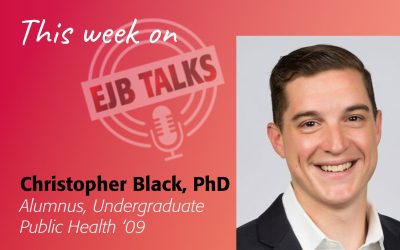On this week’s episode of EJB Talks Stuart Shapiro welcomes Professor Sharifa Williams. With her undergraduate roots at Rutgers’ Douglass College, Stuart and Shar discuss the inspiration for her path to an academic career in public health and biostatistics. Shar shares the research she has done in areas of depression, anxiety, suicide, and PTSD, and the findings that show exposure to discrimination and socio-economic disadvantages impact health outcomes. She also talks about her future projects including research on allostatic load where she hopes to create an index of exposures to discrimination, economic disadvantages, and cumulative life stress that likely have a physiological impact.
Stuart Shapiro
Welcome to EJB Talks. I’m Stuart Shapiro, the interim dean of the Bloustein School, and the purpose of this podcast is to highlight the work my colleagues and our alumni in the fields of policy, planning, and health are doing.
We are spending this, our eighth season, meeting with our new faculty at the Bloustein. School. We hired more than 10 in the past year in a wide array of fields as the shows this season will demonstrate. Today we’re talking to one of our new professors in the public health arena, Professor Shar Williams. Welcome to the podcast, Shar.
Shar Williams
Thank you so much, Stuart.
Stuart Shapiro
So you’re new to the Bloustein School as a professor, but you’re not new to Rutgers. So tell us a little bit about your history with this venerable institution.
Shar Williams
Happy to. So, I guess, X number of decades ago, I attended the illustrious Douglass College, very proud of my alma mater. I spent my undergrad career at Douglass College at Rutgers University here in New Brunswick. And I truly treasure my years as an undergrad at Rutgers. Not only do I have the best memories, and made lifelong friends, my sophomore year roommate is my best friend to this day. But this is also where I discovered my… This is where I discovered research and public health. And that’s where I discovered my love and affinity for teaching as well. So lots of beginnings here at Rutgers.
Stuart Shapiro
And you decided to come back. So you really did like it.
Shar Williams
I did!
Stuart Shapiro
We’re grateful for that, for sure. Now, within Rutgers, of course, within the vast array of fields you could have studied, you chose public health, and you chose sort of the disparities that we’ve seen in public health to study. What made you do that?
Shar Williams
I guess, let’s see, I took a circuitous route to public health. I was an economics major and math minor, as an undergrad, and I thought, oh, I’ll go work in corporate America. This is what I thought. But one day, the winter of my junior year, a flyer kind of happened in front of me. It was at Douglass student college, and it was a flyer for a summer program, Project Learn. It no longer exists here, but it was a training program, a summer intensive, that introduced students to research, you’re paired with a mentor, and you’re able to take some courses and research methods and be introduced to statistical software. And I think build career curiosity, ask questions and get some foundation to help you make decisions about whether or not you could go on to grad school. And that’s really what kind of piqued my interest.
So there I was able to really learn about health disparities. And not only what they were but kind of how they come to be. Not by happenstance, and not just through your social identity, but through like a whole host of history and political and important contexts. And so, I mean, I don’t know if I’m showing myself as a nerd, but what’s more fascinating than that? Seeing how these things kind of play out.
And it just breeds more curiosities. And so I thought, What a great way to use some of the quantitative skills I have then to kind of learn more about those things that interest me. So that’s my route to public health and health disparities, and, then kind of mixing it with my interest in quantitative skills. And so thinking about how I can use those to answer interesting questions, or pose new questions has just been fascinating.
Stuart Shapiro
That’s great. I will tell you two things that you have in common with many of our other guests. First of all, many of us took circuitous routes to get where we are today. 25-year-old me would never believe it if you told him, I was a dean, much less a professor. So yeah, we all took a strange path to get where we are.
And second, as much as we might all want to deny it, we’re all nerds. So we wouldn’t be doing what we did if we didn’t have some serious nerdy qualities in us there. So You’re among friends in both of those ((laughing)).
Shar Williams
((laughing))
Stuart Shapiro
So you said you know you get to study interesting questions. I want to ask you a little bit about some of the interesting questions that you do study. And you study some really tough stuff like depression and suicide and PTSD. Before we sort of get into your findings on this, this is obviously not an easy area to get data on. So I’m wondering, where do you get the material that you use to apply your quantitative skills to these really hard questions?
Shar Williams
Where do I get my data? So, part of my circuitous route is that I collected a lot of degrees on the way. So in addition to having an MPH, I have a graduate degree in biostatistics. And I think one of the benefits of that is that there’s always a need for a biostatistician. And there are always really qualified researchers doing exciting work, and they need a methodologist on their team. And so I think, since my grad school years, I had been able to participate and collaborate on a lot of really interesting studies.
And I just was able to, or are blessed to make a strong collaboration with a developmental psychologist researcher who was doing work that very closely aligned with mine. And was in a place that was able to welcome not only my expertise as a statistician but able to invite my independent research and my subject area expertise. And so it was really just a perfect, a really perfect coincidence, that’s really been rewarding for me. So I’m able to kind of exercise my quantitative methodological skills, and start asking interesting questions and answering those questions and really play a role in building up what kind of questions get asked and what kind of work we can look at.
Stuart Shapiro
So let’s get to those answers, then. What have you found regarding these key factors that lead to these disparities between more well-off white populations and black and Latin X populations, particularly regarding these tough issues like anxiety and depression?
Shar Williams
So the work I’ve done in this area of depression, suicide anxiety, and PTSD, has largely focused on survey data. And both data sets that I’ve worked on, actually, are collected from populations in New York. And so ones based out of Washington Heights, which I’m not sure if many know is a predominantly Latinx population. And then the other is a longitudinal study that was collected first in 1990, in East Harlem, from middle schools and high schools, so the population is predominantly black and Latinx. And in both these populations, we’ve asked important questions about socio-economic disadvantage, other experiences with respect to racism, discrimination, and experiences in the health care and treatment facilities. And we’ve also been able to ask questions, important screeners like the PHQ 910, which is a 10-item screener for depression, and other important screeners for PTSD, and anxiety and able to associate experiences of discrimination, socio-economic disadvantage, and important mental health outcomes.
And I’ll kind of highlight two main findings. In one particular study, my interest really is looking at the diagnosis of these conditions. And so, in that study, we’re looking at how many people have been diagnosed by a medical or clinical provider and then looking at results from screeners that give an indication of the symptomology of these diseases. To look at how many are actively diagnosed and potentially in treatment, and how many have undiagnosed mental health conditions and are not receiving treatment, as an indication not only of undiagnosed mental conditions but also to speak to some nontraditional assessments and means of identifying this population. Which is known to have less traditional symptomology with respect to depression, and anxiety, and thinking about how these screeners and how these clinical diagnoses work and thinking about which other partners can be involved in the diagnosis and treatment of marginalized populations, right? So thinking of nontraditional routes of accessing care, thinking of ways to get folks into screening and therefore treatment. So that’s one aspect of it, the diagnosis and the identification. And then the other aspect of it is looking at the impact of exposure to discrimination, and socio-economic disadvantage on health, and one of those health outcomes is depression and anxiety. So there’s kind of like two things going on.
Stuart Shapiro
And so you just so it’s clear in my mind, so you do find a lot of sort of undiagnosed conditions. People that are sort of scoring high on the screener, if you will, but not having formal diagnoses is a particularity among these disadvantaged populations.
Shar Williams
Exactly. So what we find there, and in that study, we have both non-Hispanic white, people of Latin X and Hispanic descent, as well as African American and Black populations in the Washington Heights sample. And what you see is higher levels of undiagnosed depression, among marginalized communities. And in that particular paper that we are discussing, we also talk about what that looks like in terms of cost. Cost with respect to the quality of life.
Stuart Shapiro
So do the, and you may not know this, because it’s probably outside the scope of your study, but does the lack of diagnosis come because people don’t think to go to a doctor and talk about the symptoms, or is it because they go to the doctor, and probably because of who they are, the doctor dismisses the symptoms as possible signs of a medical cause? Or is it something else entirely?
Shar Williams
It kind of is a little bit out of my scope, but in my discussion, and in my thinking about this topic, I’ve, and as I am want to do go off on tangents– and so I’ve done quite a bit of reading…
Stuart Shapiro
Me too as you notice. ((laughing))
Shar Williams
((laughing)) Reading on it, I think a number of things can be happening here. There are considerations with respect to how these diagnostic criteria are developed, and the populations on which they’re trained. And so there is that consideration about whether some of the populations that are represented in my study, some of these marginalized groups are part of the clinical assessments and development of these diagnostic criteria. And then the other thing is about the relationship between these populations and health services. And so whether or not they’re actually seeking that kind of care, or they’re in the space, to get that kind of care.
And in some of my reading I did find that there is now the well, some healthcare organizations have started instituting like a PHQ-2. So that’s a two-item questionnaire screener for folks who walk into the ER, for example. So they can get a little screener to be more quickly identified, because many times, you don’t get to see these patients and be able to give them this kind of screening or be able for them to get this kind of attention.
And then another thing, which is related to the first point is how depression, or mental ill health kind of shows up in different populations. And whether not only the screeners and the tools that are used to assess but whether the places that people attend for that kind of support, so maybe it’s not a medical location, perhaps we need to be looking at community organizations, perhaps we need to be looking at traditional places of care, which sometimes can be religious organizations and some groups or some other kinds of social spaces. So those are some of the things I’ve been thinking about, and I’ve read about. But yes, not really directly my exact scope, but certainly something I’m interested in and I have been reading quite a bit about it.
Stuart Shapiro
Right. I don’t imagine you can be immersed in these things and not think about those kinds of questions.
Shar Williams
Right.
Stuart Shapiro
As you’re doing them. Relatedly your answer sort of points a little bit in this direction. What in terms of what do we do about it? And you talked about churches and community organizations, you talked about changing diagnostic tools, etc. Is there anything else we should be thinking about as implications of your work?
Shar Williams
You know, to go back to the changing of the diagnostic tools I … Really truly the crux of the matter is a lot of the burdens so the exposures to discrimination, financial distress, and life stress, kind of get under the skin and affect people physiologically. And this is what we see when we talk about allostatic load and cumulative stress and weathering related to experiences. And so I almost backed off of the diagnosing and really focused in on all the structural or the systematic and systemic ways in which marginalized folks are experiencing distress and stress and how that shows up in your mental health outcome, but also in your biologic like physical health markers.
And so I guess it’s me wanting to highlight more a lot of the structural and systematic ways that this burden is built. And not focusing too much, not for lack of importance, but just for the fact that it you know, like if to focus somewhere on those, those kinds of exposures, while recognizing that, of course, how one diagnosis… and kind of, I feel like that’s more tied to payment, and I want to focus more on the structures that exist to kind of perpetuate a lot of these health outcomes.
Stuart Shapiro
Right. Well, that leads me to my last question, what next? What kind of… can you tell us about one or two, sorts of things you’re going to be working on in the next year or two?
Shar Williams
Oh, my goodness, one of the harder questions to answer because I have so many ideas. Oh gosh….
Stuart Shapiro
I know. I know… You’ve got to pick out the one that listeners….
Shar Williams
OH… pick out one?!
Stuart Shapiro
…are going to say “Ooh that sounds cool”.
Shar Williams
I think the closest at hand I’m working on is some papers that look at the association between discrimination and socio-economic disadvantage, and allostatic loads. I’m quantifying cumulative stress using a number of biomarkers from saliva, dried blood spot, as well as some anthropometric measures to create an index called allostatic load wanting to see how discrimination and economic disadvantage kind of gets under the skin to lead to this cumulative stress burden called allostatic. load and how that in turn impacts health. So that’s where I am right now.
Stuart Shapiro
How are you going to measure the independent variables there? The discrimination piece?
Shar Williams
So the discrimination piece? It’s a good question. So right now we have about 30 years, eight-time points of self-reported experiences of interpersonal discrimination, and internalized discrimination, as well as a number of measures on socio-economic disadvantage having to do with educational attainment, income, and financial stress. But I’m hoping in the very near future, within the next year or so to extend this work to include measures of structural racism. So we have for these, these individuals also residential information, and so we can try to, as best as we can, capture inequities on a number of socio-economic markers at the zip code level, and to see how we can incorporate that in the analysis. But that’s further out.
Stuart Shapiro
Yup, I can see that. Yeah, like housing and education.
Shar Williams
Exactly. Incarceration, etc.
Stuart Shapiro
Gotcha. Fascinating stuff. Shar, thanks so much for coming on the podcast.
Shar Williams
Thank you so much for having me. This was fun. ((laughing))
Stuart Shapiro
((Laughing)) We’ll have you back.
Shar Williams
Of course!
Stuart Shapiro
A big thank you to Shar as well as to our production team, Amy Cobb and Karyn Olsen. We’ll see you next week with another talk from another expert at the Bloustein School. Until then, stay safe.



